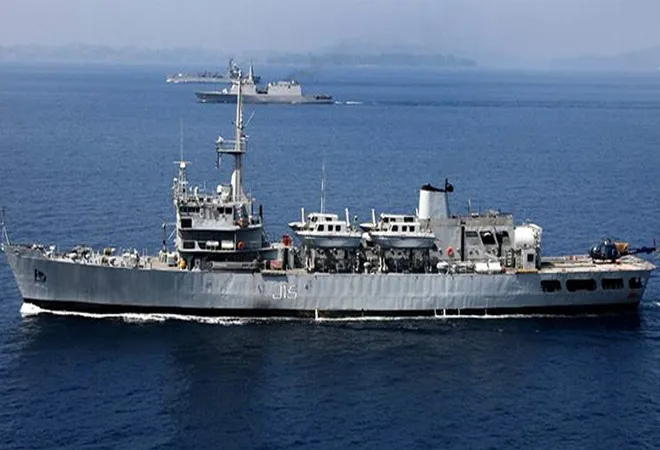The India-Bangladesh maritime connectivity has been given a major boost with the successful trial of the transhipment of goods to India’s north-eastern States
via the Chittagong port. On 18 July, mv Shejyoti, a ship with cargo for Bangladeshi businesses and also four containers bound for Indian States of Tripura and Assam, set sail from the Shyama Prasad Mukherjee Port at Haldia in West Bengal, India, for Chittagong. The journey was historic since this was the
first trial of the transhipment facility to India’s landlocked north-eastern region
via the Chittagong port. The move is expected to strengthen the bilateral as well as the economic ties between the two countries.
This transhipment facility is an outcome of the bilateral
agreement signed in 2018 to allow the use of Chittagong and Mongla ports for the purpose. Additionally, a
standard operating procedure was signed during Prime Minister Sheikh Hasina’s visit to India in October 2019. The SOP allows transhipment of goods from Chittagong and Mongla on four road, rail, and water routes to Agartala (Tripura)
via Akhaura; Dawki (Meghalaya)
via Tamabil; Sutarkandi (Assam)
via Sheila; and Srimantpur (Tripura)
via Bibirbazar. During the trial, the cargo destined for the north-east India was transported from Chittagong to Agartala by road.
The beginning of this transhipment facility is a telling example of the cooperative attitude that guides the bilateral relationship. The move corresponds the two nations’ vision to strengthen the bilateral connectivity and develop a mutually-beneficial partnership for the shared good of the people living across the border. At the flag-off ceremony, India's Shipping Minister Mansukh Mandaviya observed that the transit route will open new opportunities for both countries. During a webinar on India-Bangladesh relations, Bangladeshi State Minister of Shipping Khalid Mahmud also opined that the trial run will open a
new horizon for the two countries.
Access to Chittagong and Mongla ports has been a phenomenal step as it will not only help the region to be relieved of its land-locked status but it will also add an alternative connectivity route. Besides these, the expectation is that it will also augment development and
improve trade since the facility is likely to reduce time and distance substantially, making trade viable.
Revenue-generation
Bangladesh is likely to get some benefit. Observers feel that the facility will contribute to enhancing business services and revenue generation in the country. It is expected to help Bangladesh in job-creation and investment in the logistical sector since Bangladeshi vessels and trucks will be utilised to move the Indian cargo. Indian cargo also has to pay
requisite taxes to use the facility in Bangladesh.
The facility is considered to be the first step in fulfilling the present Awami League government’s desire to transform Bangladesh into a connectivity hub. Generally, the response it positive. But, some media reports have criticised the government, saying Indian vessels were given
priority at the Chittagong Port. However, Chattogram Port Chairman, Rear-Adm S.M. Abul Kalam Azad,
nullified the media’s claim and termed it as misleading. He said that Indian vessels will be treated like any other foreign vessels.
Some vested quarters have not been happy about the improving relations with India. The present development showcases the resolve of the two countries to constantly work for enhancing the bilateral relationship, which has been growing steadily for more than a decade. Enhancing connectivity has been a priority in the plan. In this respect, the two nations have been focusing on strengthening cooperating on maritime and inland waterways connectivity.
In 2015, India and Bangladesh had signed a coastal shipping agreement. Also, efforts have been made to expand the use of waterways for trade and connectivity. India is helping Bangladesh in increasing the navigability of the rivers by assisting in the dredging of its waterways in selected stretches. There is already a
Protocol on Inland Water Trade and Transit and a new port of call and routes has been added. This was done in May 2020, with the two countries signing
an addendum to the protocol, adding two new routes and 5 new port of calls on each side. Currently, Inland water protocol has a total of 10 routes and 11 port of calls on each side.
The India-Bangladesh connectivity is not only aimed at improving the movement of goods and people bilaterally but also has a vision for deepening sub-regional cooperation, primarily Bangladesh, Bhutan, India and Nepal (BBIN) quadrilateral cooperation. The recently added port at Jogikhopa is expected to facilitate inland water connectivity to Bhutan.
In this complex sub-regional geo-politics, India and Bangladesh provide a unique model of good-neighbourly relationship, anchored in the vision of peaceful co-existence and sharing a prosperous neighbourhood by growing together hand-in-hand.
This commentary originally appeared in South Asia Weekly.
The views expressed above belong to the author(s). ORF research and analyses now available on Telegram! Click here to access our curated content — blogs, longforms and interviews.




 PREV
PREV


